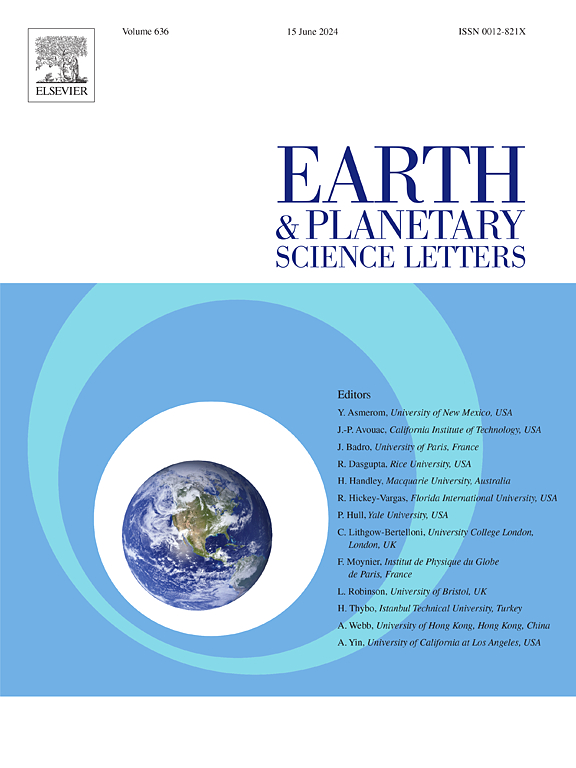从万代到世:多重分形地质年代与复合多重分形-泊松过程
IF 4.8
1区 地球科学
Q1 GEOCHEMISTRY & GEOPHYSICS
引用次数: 0
摘要
地质时间被定义生物地层的事件和地质时间尺度(GTS)的年代、年代、时期、时代、年龄层次所打断。古温度和宏观演化速率已经表明,从≈1迈至(至少)几百迈的范围是一个尺度化的(因此是分层的)“大气候”体系。我们应用Haar涨落、结构函数、迹矩和扩展自相似性等分析技术对两个全局和四个区域序列的边界事件(ρ(t))的时间密度进行了分析。我们证明ρ(t)本身是一个新的古指标,并确定了表征平均波动、间歇和多重分形程度的基本多重分形指数。强烈的间断性使我们能够证明(最大)大气候尺度至少为≈0.5 Gyr。我们发现,边界之间的间隔(“间隙”)的概率分布的尾部也以指数qD≈3.3缩放,表明偶尔有非常大的间隙的巨大可变性,使得它的三阶统计矩几乎不收敛。在时间上的缩放意味着记录的不完整性随着其分辨率的增加而增加(“分辨率Sadler效应”),而在概率空间上的缩放意味着不完整性随着样本长度的增加而增加(“长度Sadler效应”)。事件边界的密度描述只有在足够长的时间间隔内(通常存在一个或多个事件)才有用。为了模拟整个尺度和密度范围,我们引入了复合多重分形-泊松过程,其中从属多重分形过程决定泊松事件的概率,并且这个新过程接近观测到的统计量。尺度改变了我们对生命和地球的理解,它是许多统计古生物学和地质学分析的必要条件,包括对来自古气候和古环境档案的大量地理数据进行无偏光谱分析。本文章由计算机程序翻译,如有差异,请以英文原文为准。

From eons to epochs: multifractal geological time and the compound multifractal - Poisson process
Geological time is punctuated by events that define biostrata and the Geological Time Scale’s (GTS) hierarchy of eons, eras, periods, epochs, ages. Paleotemperatures and macroevolution rates, have already indicated that the range ≈ 1 Myr to (at least) several hundred Myrs is a scaling (hence hierarchical) “megaclimate” regime. We apply analysis techniques including Haar fluctuations, structure functions, trace moment and extended self-similarity to the temporal density of the boundary events (ρ(t)) of two global and four zonal series. We show that ρ(t) itself is a new paleoindicator and we determine the fundamental multifractal exponents characterizing the mean fluctuations, the intermittency and the degree of multifractality. The strong intermittency allows us to show that the (largest) megaclimate scale is at least ≈ 0.5 Gyr.
We find that the tail of the probability distribution of the intervals (“gaps”) between boundaries is also scaling with an exponent qD ≈ 3.3 indicating huge variability with occasional very large gaps such that it’s third order statistical moment barely converges. The scaling in time implies that record incompleteness increases with its resolution (the “Resolution Sadler effect”), while scaling in probability space implies that incompleteness increases with sample length (the “Length Sadler effect”).
The density description of event boundaries is only a useful characterization over time intervals long enough for there to be typically one or more events. In order to model the full range of scales and densities, we introduce a compound multifractal - Poisson process in which the subordinating multifractal process determines the probability of a Poisson event and that this new process is close to the observed statistics.
Scaling changes our understanding of life and the planet and it is needed for unbiasing many statistical paleobiological and geological analyses, including unbiasing spectral analysis of the bulk of geodata that are derived from paleoclimatic and paleoenvironmental archives.
求助全文
通过发布文献求助,成功后即可免费获取论文全文。
去求助
来源期刊

Earth and Planetary Science Letters
地学-地球化学与地球物理
CiteScore
10.30
自引率
5.70%
发文量
475
审稿时长
2.8 months
期刊介绍:
Earth and Planetary Science Letters (EPSL) is a leading journal for researchers across the entire Earth and planetary sciences community. It publishes concise, exciting, high-impact articles ("Letters") of broad interest. Its focus is on physical and chemical processes, the evolution and general properties of the Earth and planets - from their deep interiors to their atmospheres. EPSL also includes a Frontiers section, featuring invited high-profile synthesis articles by leading experts on timely topics to bring cutting-edge research to the wider community.
 求助内容:
求助内容: 应助结果提醒方式:
应助结果提醒方式:


